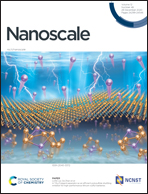Microtip focused electrohydrodynamic jet printing with nanoscale resolution†
Abstract
Electrohydrodynamic jet (E-Jet) printing is a promising manufacturing technique for micro-/nano-patterned structures with high resolution, high efficiency and high material compatibility. However, further improvement of the necking ratio of the E-Jet is still limited by the focusing principle. Moreover, ink viscosity is limited to values well below 90 mPa s owing to the high probability of nozzle blockage. Here, we propose a microtip focused electrohydrodynamic jet (MFEJ) printing to overcome these limitations. This technique uses a solid microtip with a radius of curvature (ROC) of several micrometers rather than a hollow nozzle, which is very simple and highly efficient to prepare and can effectively avoid nozzle clogging problems even with high-viscosity printing ink. High-resolution patterns in diverse geometries were printed using different inks with a wide range of viscosities (8.4–3500 mPa s). Nanodroplets with an average diameter of 73 nm were achieved. Moreover, nanofibers with a diameter of 30 nm were obtained using a 4 μm ROC microtip and the necking ratio was as high as 266 : 1. To the best of our knowledge, this is the smallest droplet or fiber diameter directly obtained via E-Jet printing to date without further physical or chemical processing. This MFEJ printing technique can improve printing resolution at the nanoscale, significantly enlarge the material applicability and effectively avoid nozzle clogging for the fabrication of nanodevices.



 Please wait while we load your content...
Please wait while we load your content...